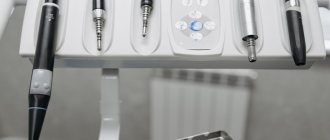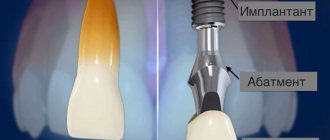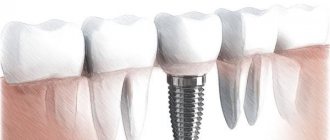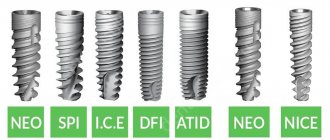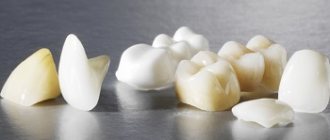More than 7 million people around the world have received dental implants to restore one, several or all teeth. Dentures on implants are a reliable, safe and well-researched method of restoring the aesthetics and functionality of the dentition: you can smile beautifully again and eat your favorite food without restrictions.
For those planning to install implants, we have prepared answers to the following questions:
Contraindications for installing titanium rods
Does it hurt during implant placement?
Installation stages (step by step with deadlines)
What not to do after installation?
What complications can there be after implantation?
Guarantees for implant installation
Contraindications
| Absolute (operation impossible) | Relative (the operation is temporarily postponed) |
|
|
Types of implantation techniques, terms of prosthetics –
There are several classifications of implantation techniques, but the generally accepted classification is one that takes into account the timing of the load on the implant (the term “load on the implant” can be understood as the timing of prosthetics). There are three options for loading the implant:
- Immediate loading - in this case, the temporary crown or bridge is fixed - either immediately after installation of the implant, or within the first 72 hours after surgery. An implantation technique that uses immediate loading is often called “single-stage dental implantation.” The advantage of this technique is that you get a crown or a fixed bridge immediately – even if it’s temporary (made of plastic or metal-plastic). At the very least it gives good aesthetics.
- Early loading - in this case, prosthetics are carried out within 2-6 weeks after implantation. To ensure such an early load, an implantation technique is used, which is called one-stage dental implantation. This type of implantation implies that the surgical protocol will be completed in 1 stage - this means that at the end of the operation, a gum former will be immediately installed into the implant. We will describe each method in more detail below.
- Late loading – late loading means that prosthetics are usually performed either 3-4 months after installation of the implant, or after 6-7 months (if the doctor performed bone grafting in parallel with the installation of the implant). There are two implantation methods that use late loading on the implant - one-stage or two-stage dental implantation.
It turns out that we have three main implantation methods - 1) two-stage implantation, 2) one-stage implantation, 3) one-stage implantation. And now we will tell you about them in as much detail as possible.
Does it hurt during implantation?
All procedures are carried out under local anesthesia, so the patient does not experience any painful sensations - he only feels the mechanical work of the doctor in the mouth, as during conventional dental treatment. In fact, the manipulations performed when installing an artificial root are less invasive and traumatic than when removing a tooth.
If you are very worried and are terrified of the upcoming operation, the clinic may offer implantation under sedation - in a relaxed state, but in full consciousness. The patient is given drugs that put him into a light sleep and he ceases to experience anxiety.
What is the cost of dental implants?
The process of dental implantation is quite complex, with many subtleties and nuances. Therefore, its price is appropriate. In dentistry, the minimum cost of a South Korean implant and its installation is 18,000 rubles. It comes with a five-year warranty, but with adequate care it will last you a lifetime. German implants are more expensive - from 30,000 rubles, but they have a lifetime guarantee. The cost of implants for a one-step technique is 36,000 rubles. The price list of premium level products starts from 42,000 rubles. Additional manipulations, such as bone grafting, are paid separately. Bone tissue augmentation costs from 18,000 rubles to 40,000 rubles, depending on the complexity of the operation. The cost of a temporary crown is 12,000 rubles, a permanent one - from 18,000 to 34,000 rubles. Dentures on implants cost from 64,000 to 190,000 rubles.
Stages and deadlines
1. Initial appointment (up to 20 minutes).
The implant surgeon gets to know the patient. Visually examines the oral cavity, assessing the current health of teeth and gums. To exclude the presence of contraindications and analyze the possible risks of complications after implantation, the doctor collects an anamnesis - information about the patient’s living conditions, diseases, bad habits, pharmaceuticals taken, etc. Answers any questions that may arise.
In what cases is it recommended to undergo tests before implantation?
Additional examination is necessary if the patient:
- has a chronic disease;
- undergoing any treatment;
- in the last 1-2 months, suffered from a serious illness or underwent surgery.
2. Comprehensive hardware diagnostics (up to 30 minutes).
Includes:
- Sight shot
. Necessary for assessing the condition of teeth located adjacent to the implant installation site. Detects inflammatory processes at the apex of teeth, hidden fractures/root injuries. Helps assess the quality of installed fillings (if any). Eliminates the risk of infection from neighboring teeth getting into the socket when an artificial root is implanted. - Panoramic photo (orthopantomogram)
. This three-dimensional image allows you to visualize the upper and lower jaws in an expanded plane. OPTG helps the doctor give an initial assessment of the condition of each tooth, its canals and roots, periodontium, maxillary sinuses, sinuses and other structures of the dental system. - CT (computed tomography)
. Allows you to study in detail the required area of the jaw in any plane at the required angle. Reveals hidden inflammatory and pathological processes in the periodontium. Helps to select the optimal dimensions of the titanium rod, as well as the installation location. Eliminates damage to the maxillary/mandibular nerve and blood vessels during implant installation. Provides important information for 3D modeling of the surgical process.
3. Computer modeling (2-3 days).
Three-dimensional visualization allows the implant surgeon to calculate and see the result of treatment before it begins.
The software helps the doctor determine the optimal locations for installing implants, taking into account the density and volume of bone tissue, select a titanium rod model, and calculate the angle and depth of implantation. The human factor is excluded, the result of implantological treatment is calculated with high accuracy. 4. Preparation (sanitation) of the oral cavity.
Before implantation, it is important to carry out professional dental hygiene (cleaning from plaque and tartar), eliminate existing inflammatory foci, and cure dental diseases identified during diagnosis (caries, pulpitis, etc.).
Jaw implantation using All-on-4 or All-on-6 technology also requires the preliminary removal of existing teeth, since a complete fixed prosthesis of 12 or 14 crowns is installed.
5. Osteoplasty.
If there is insufficient bone tissue volume, before installing a titanium rod, one of the following methods is used to build it up:
- Alveolar ridge clefting
. The doctor makes a cut into the alveolar process (the part of the jaw into which titanium screws are implanted) and increases its thickness using artificial bone material or graft. Installation of the implant is possible after 4-6 months. - Guided bone regeneration
. During the operation, the doctor places a synthetic bone analogue into the jawbone and covers it with a protective membrane. The patient's blood plasma is used to stimulate bone tissue growth. Implantation is possible in 3-6 months. - Sinus lift
. The volume of bone tissue in the area of the maxillary sinuses increases. There are open (more extensive surgery used for severe bone atrophy) and closed sinus lift (less invasive, with a slight lack of bone height).
Our clinic uses Straumann Roxolid implants, which allow us to avoid bone grafting in 95% of clinical situations, both when restoring one tooth and during total prosthetics of a toothless jaw!
6. Surgery (15 minutes).
Under local anesthesia, the doctor makes an incision in the gum and lifts flaps to gain access to the jawbone.
Then he prepares the implantation bed by drilling a hole of the required depth in the bone. After checking the depth of the canal with special tools, the implantologist bores it to the required width.
A titanium rod is implanted into the resulting hole. Its model, length and thickness are selected at the 3D modeling stage.
The implant is closed for 2-6 days with a plug, which protects the artificial root from microbes and mechanical influences.
The gum is sutured, closing the temporary plug.
On days 3-7 after implantation, the sutures are removed and an abutment is installed.
7. Orthopedics.
It takes place in two stages. At the first visit, an impression is taken within 20-30 minutes, on the basis of which a temporary crown will be made in the dental laboratory. At the second visit (after 2-3 weeks, depending on the clinical picture), the prosthesis is fixed to the abutment (duration - up to half an hour).
How are dental implants done today?
Almost all patients who decide to undergo this operation are concerned about the question of how dental implantation works. The procedure involves the following steps.
- An implant is placed in the prepared hole, then it is covered with a gum flap, sutured and wait until it integrates. Healing of the implant takes several months: about two or three - on the lower jaw, from four to five - on the upper jaw.
- A small circular incision is made in the gum and a gum former or abutment is installed on the implant and loaded with a temporary crown.
- Impressions are taken, a permanent crown is made and installed on the implant.
Immediately installing a permanent crown is not recommended, as it puts strong pressure on the implant, which leads to its rejection. The two-stage technique is ideal for smokers and patients who do not take good care of hygiene - bacteria will not be able to penetrate into the closed socket, and the risk of implant rejection will be minimized.
The two-stage method is most often used to restore already missing or traumatically removed teeth, when there is not enough bone tissue in the area where the implant is installed. In these common situations, bone volume needs to be increased. Sometimes this manipulation can be carried out simultaneously with the installation of the implant, but most often it is necessary to postpone the implantation for several months and wait until the required volume of bone tissue is formed.
The process of installing a dental implant before and after
Implant installation methods
Installing implants allows you to replace missing teeth with new ones that are practically no different from natural ones. Today, there are several main options and ways to install an implant.
Classic implantation
Classical implantation allows you to insert implants in any quantity, even in the absence of teeth in the oral cavity. This process is very lengthy, however, in the end it gives an excellent result. The chewing function and aesthetics of the smile are completely restored. At the first stage of implant installation, artificial roots (the basis of the implants) are implanted into the bone tissue. Then the abutments (support for the crown) are implemented, and only after that it becomes possible to place a dental implant.
One-stage implantation - we will place the implant immediately after tooth extraction
In some cases, an implant can be installed immediately after tooth extraction, without waiting for the tissue to heal. This option allows you to prevent bone tissue atrophy, however, the operation can be performed only in the absence of any acute diseases of the teeth and gums in the patient.
Express implantation
In the case of express implantation, the implant and crown can be installed immediately after it is implanted into the bone. Place an implant
This method is possible provided that one or more teeth located at a distance from each other are restored. A combination of express implantation with other methods is often practiced, provided that express is used for the front teeth. It is possible to place a dental implant using the express method, provided that inflammatory diseases in the patient’s oral cavity have been treated, and there is no need to build up bone in the place of the missing tooth.
Implantation with early loading (from 2 to 6 weeks) –
Implantation with early loading of the implant means that the fixation of the crown or bridge will be carried out within 2 to 6 weeks. Before the advent of modern models of implants with ultra-hydrophilic surfaces, early loading was applied within a period of 4 to 6 weeks, but increasingly advanced implant surfaces make it possible to shift these periods.
Not every type of dental implant is suitable for the early loading technique. And here it is not only the specific nature of the thread that is important, due to which good primary stability of the implant can be obtained. But despite the fact that the implant may have good primary stability immediately after installation, after 2-3 days the process of traumatic bone tissue resorption will begin around the implant. This process (depending on the nature of the thread and the method of preparing the bone bed for the implant) can take up to 2-3 weeks.
Such traumatic resorption worsens the stability of the implant during this period (let's call it secondary stability). The ultra-hydrophilic surface of the implants, as well as the treatment of the surface of the implants with surfactants (fluorine ions, phosphates), allows to reduce traumatic resorption, and therefore the secondary stability of the implant will be sufficient to begin prosthetics. The best implants for early loading, in our opinion, are Straumann (Switzerland), and in second place is Nobel Biocare (Switzerland).
Important: the indication for early loading is usually a single missing front tooth, when the patient needs to quickly restore aesthetics. In this case, a temporary plastic crown is first made, preferably using the milling method (CAD/CAM). Over time, it will be replaced, for example, by metal-free ceramics made of zirconium dioxide.
Recommendations after implant installation
- During the first 2-3 hours after surgery, eating is strictly not recommended. What happens if you neglect this? Disastrous consequences include: sutures coming apart, infection of the titanium rod installation site, biting the tongue or cheek.
- On the day of surgery, you do not need to brush your teeth or rinse your mouth. Starting from the second day, you can clean them, but with a soft brush. It is better not to touch the operated area. You can also rinse your mouth with an antiseptic solution after eating, but very gently.
- For the first two to three days, you should strictly not consume hot/cold food or drinks. It is recommended to exclude sour and spicy foods from the diet. You can eat broths, yogurt, and pureed foods.
- For 2-4 weeks, avoid air travel, saunas, increased physical activity, and hypothermia. Otherwise, the risk of implant rejection increases.
- Completely stop smoking and drinking alcoholic beverages for at least five days. During the period of osseointegration of implants (3-6 months), reduce the number of cigarettes smoked to a minimum.
Compliance with the following rules will not only help shorten the rehabilitation period, but will also minimize the risk of complications.
Rating of the best implant manufacturers –
There are statistical data on which manufacturers’ implants are considered the best among implant surgeons, and, in our opinion, this speaks quite clearly about their quality. We deliberately place emphasis on the choice of implant surgeons, because... they approach the choice of implantation system consciously, striving to obtain a minimum number of complications after installing implants.
Reviews of dental implantation from patients are always more subjective. For example, only for the reason that the patient can never distinguish what exactly caused the unsuccessful dental implantation - mistakes made by the implantologist or the insufficient quality of the dental implant itself.
Implants are the most popular in Europe –
- Straumann (Switzerland) – about 18% of the implant market,
- NobelBiocare (Switzerland) – 17% of the market,
- AstraTech (Sweden) – 15% of the market,
- 3i Biomet – 7%,
- Zimmer – 6%,
- the remaining 37% of the implant market is divided among a large number of smaller manufacturers (in total there are just over 400 implant manufacturers in the world).
Important: Straumann and NobelBiocare implants are widely available in Russia, but AstraTech is offered much less frequently in dental clinics. All of them are of very high quality and reliability, but certainly cannot be called budget. If you choose such premium manufacturers, then prices for dental implantation in Moscow will start from 70,000 rubles per tooth. This cost also includes a titanium abutment with a metal-ceramic crown.
Israeli and Korean dental implants, AlphaBio or Osstem, will be much more affordable. If you choose these manufacturers, then the cost of turnkey dental implantation will be from 40,000 rubles per tooth (including metal-ceramic prosthetics). But these implants are no longer suitable for all implantation techniques; secondly, they behave worse in conditions of insufficient bone volume, and thirdly, they are less suitable for implantation in the aesthetic zone, i.e. in the area of the front teeth.
Complications - when should you see a doctor?
If you experience any of the following symptoms, contact your doctor as soon as possible:
- After the 3rd day of surgery, pain gradually increases
. It is quite normal to experience minor pain for the first 2-3 days, but no more. - On the 4th day the swelling began to increase with an increase in body temperature
. Normally, it should subside on the third day. If it grows, then there is a problem. - After 4-5 hours, the surgical wound continues to bleed
. Minor bleeding in the first 2-3 hours is normal. But you should be wary if the wound continues to bleed. - Part of the face became numb, and there were difficulties opening the mouth
. This is due to stretch/compression or injury to the nerve. It occurs very rarely (in less than 3% of patients) and is associated with physician error. - The temperature rose sharply to 39° on the fourth day
. An increase in body temperature to 38° in the first three days after surgery is a completely normal reaction of the body to surgery. But if after three days you notice a sharp increase in temperature, then you need to consult a doctor. - Purulent discharge appeared from the implant site
. This indicates the presence of an inflammatory process due to infection of the hole.
How to choose the right implant type –
If you need implantation in the area of the front teeth (and even more so if there is a deficiency of bone volume at the same time), more expensive implants with a hydrophilic surface will be optimal.
The best is Straumann, then NobelBiocare or AstraTech. In addition, during operation, these implants practically do not cause bone atrophy around the neck, which is very important for maintaining the beautiful appearance of the gums. The latter is very important when it comes to the front teeth, and at the same time you have a “gummy type of smile” (i.e. with exposure of the gums). There are implantation methods when prosthetics with a crown are carried out already 2-5 weeks after surgery, or even immediately after surgery (in the latter case, a temporary crown made of plastic is first made). If you want such an early load, then this is only Straumann or NobelBiocare. If you are a patient at risk, then in smokers, patients with osteoporosis, diabetes mellitus, older patients and hypertensive patients, it is better to use implants with an ultra-hydrophilic surface or Roott basal implants (24stoma.ru).
But if the price is of great importance, this is also not a problem, although in this case you can forget about immediate and early prosthetics. In this case, you can choose more economical implants, the installation of which would be preferable using a two-stage implantation technique (which implies prosthetics within 3 to 6 months). This implantation technique has the least number of complications even if the patient’s medical status is unfavorable. You can read more about choosing implants in the review at the link below.
→ How to choose the right type of dental implant
Answers to popular questions
Is it possible to install implants for diabetes?
Controlled diabetes mellitus is not a contraindication to dental implantation. Based on the results of the analysis for glycated hemoglobin, patients are divided into three groups:
- less than 6% - dental implants can be placed without any restrictions;
- from 6% to 8% - implantation is possible, but with minimal risk (special preparation is required);
- more than 8% - surgery is possible only after the patient reduces the level of glycated hemoglobin to the required levels.
The Family Dentistry clinic successfully performs dental implantation for diabetes mellitus according to an individual treatment plan, taking into account the specific clinical picture. We try to use technologies that allow us to avoid bone grafting - the operation is less invasive (traumatic), and healing is easier. In addition, we install Straumann implants with the hydrophilic surface SLActive, which eliminates blood supply disturbances in diabetes and promotes successful osseointegration in bone tissue.
Is it possible to place implants with periodontitis or periodontal disease?
Yes, you can. But treatment is required first, incl. Possibly gum and bone grafting.
With periodontitis, bone tissue atrophies, so osteoplasty may be required at the time of implantation of a titanium rod into the jawbone. Some clinical situations allow you to install an implant immediately after gum surgery for periodontitis, while others require up to 6 months for the bone material to engraft.
In patients with periodontitis, the gums are less dense and decrease in width and height. This is dangerous because a pocket may form between the neck of the implant and the gum, in which bacteria will accumulate. As a result, there is a high risk of titanium screw failure. That is why the dental surgeon first performs gum surgery.
What anesthesia is used to place dental implants?
Local anesthesia is most often used. It is enough so that the patient does not experience any pain when installing implants. A combination of local anesthesia with sedation (a state of drug-induced semi-sleep) helps to cope with the experience.
It is important to understand that the jawbone is not innervated. Therefore, it is necessary to numb only the mucous membrane, which local anesthesia copes well with.
Why does an implant take root faster when installed in the lower jaw than in the upper jaw?
Yes, titanium rods implanted in the lower jaw take root within 2-4 months, and in the upper jaw - from 3 to 6. This is due to the fact that the mandibular bone tissue is more dense.
What are the dangers of smoking after implantation?
Until about 10 years ago, smoking was an absolute contraindication to the installation of implants, and many dental clinics simply refused such patients who were at risk.
Nowadays, even heavy smokers are implanted, but smoking remains the worst enemy of dental implants. It promotes the growth of bacteria in the mouth and accelerates the formation of plaque. It also leads to irritation of the mucous membrane and constriction of blood vessels, slowing down the healing process of tissues after surgery. Thus, smoking not only significantly slows down the process of engraftment of artificial roots, but also increases the risk of their rejection.
Can I drink alcohol after getting dental implants?
It is advisable to avoid alcoholic beverages not only while taking antibiotics after implantation, but also for the entire period of osseointegration (i.e., 3-6 months) for the following reasons:
- irritates the mucous membrane, slowing down the process of engraftment of the titanium rod;
- dilates blood vessels, causing bleeding at the site of implantation of the artificial root;
- increases the risk of developing hematoma.
Still have questions about installing implants? Get a free consultation with an implantologist.
| Expert, author of the article: Akhtanin Alexander Pavlovich Orthopedic dentist, implantologist 35 years of implantation experience Material updated: October 11, 2022 |
How many implants are needed and which ones to choose?
Installing ten implants on each jaw is an ideal solution for patients suffering from complete edentia. However, a good result can be achieved with eight or even six implants. More economical options are removable dentures on four implants. The most budget-friendly alternative is a removable denture on two implants. Some patients believe that two or four implants will not be able to withstand the load placed on them during jaw work and will be rejected. In fact, the pressure during chewing is distributed throughout the entire prosthesis and falls not only on the implants, but also on the bone and gum, so there is no need to fear rejection.
The choice of product depends, firstly, on the volume of bone tissue. If there is a lot of bone, then any implant can be installed, and if not, then only a certain size. Secondly, from the methodology. Thus, it is possible to carry out one-stage implantation only if the implant is tightly fixed in the bone. To do this, either its rod or thread must be of large diameter. Not all companies produce such aggressive implants, so the patient has not much choice. And thirdly, from the budget.
Butterfly prosthesis
The design was named because of its external resemblance to a butterfly. Used when 1-2 units are missing. Consists of a crown and a base. This is a denture without turning; it is attached to adjacent teeth with clasps.
Materials:
- Classic polymers: acrylic, nylon
- Innovative polymers: Acry Free, Dental D
The prosthesis does not participate in the distribution of chewing load and does not prevent bone loss. It is quite fragile and cannot be repaired. They use it as a temporary measure, although they can last one to two years.
Contraindications to inserting dental implants
Implantation is not permitted in all cases. There is a list of conditions when medical manipulation is absolutely contraindicated:
- Problems with blood clotting. In this case, any surgical intervention is prohibited.
- Epilepsy. During the procedure, the risk of an epileptic seizure increases sharply.
- Exacerbation of mental illness.
- Fall of immunity. The implanted pin may be rejected.
- Connective tissue diseases. The regeneration process will take a long time.
- Syphilis, tuberculosis. The bones are affected and the screw is rejected.
- Deep periodontal disease, periodontitis.
- Severe forms of rheumatism.
- Malignant tumors. Relapse is possible.
- Allergic reactions to the materials used and medicinal formulations.
- Cardiovascular pathologies in advanced cases. Seizures are possible that can cost the patient his life.
Relative contraindications, when surgery to install a dental implant instead of a tooth is undesirable, but under certain conditions is sometimes allowed:
- Diabetes. Metabolism is disrupted, and wounds take a very long time to heal. Treatment is carried out at the compensation stage in compliance with special rules.
- Pregnancy. Accompanied by an increased risk of miscarriage.
- Exacerbation of the inflammatory process. Therapy is carried out only after complete recovery.
Installation options depending on bone type
Most implants are placed not only vertically, but also exclusively in the spongy – central part of the jawbone. But it is this section that is most susceptible to atrophy or resorption after tooth extraction. Therefore, it is not always possible to use it. Or you have to resort to extension surgery (which is quite traumatic and does not always give results the first time).
Therefore, large manufacturers have developed alternative models for installation in other bone structures (they are not new, but have existed for decades, that is, time-tested):
- basal and compression implants: for placement in deep and very dense areas that are not subject to atrophy - the basal bone and cortical plate. Such models are produced by Oneway Biomed,
- zygomatic (the most striking example is the Zygoma model from Nobel Biocare): these are long models (up to 60 mm), they are installed at an angle and only on the upper jaw. But important organs are not damaged, because In the zygomatic technique, implants are implanted not only into the maxillary bone, but also into the zygomatic bone, passing through the force lines of the skull - therefore they are fixed extremely reliably.
Does it hurt to insert teeth?
Typically, patients are interested not only in how a crown is placed on a tooth, but also how painful it is. The most unpleasant stages here, of course, are preparing teeth for prosthetics (i.e., treating them, filling root canals), and sometimes also the process of taking impressions. If already dead teeth are used for crowns, then turning them is completely painless and does not even require anesthesia. If living teeth are ground down, a local anesthetic is first injected.
The only painful moment that I myself (being a dentist) have personally experienced is when, when taking an impression, the doctor performs gum retraction. Retraction refers to the widening and deepening of the gingival sulcus, which is accompanied by a small degree of separation of the soft gum tissue from the tooth. This is done in order to make a more accurate impression of the neck of the tooth, and it is better to do this immediately under anesthesia.
All-on-6 for cancer and diabetes
Those patients who have some kind of malignant neoplasms and are undergoing treatment, if the patient is in remission and if this remission lasts more than 2 years and he tests tumor markers and everything is fine, then this patient can have implants installed, and we we install them.
Patients with diabetes are a fairly common disease now; we have many such patients.
Of course, we do not install implants as soon as the patient arrives and “everything is 6”, let us quickly install everything for you today - no, this is not our approach. The patient is interviewed, an anamnesis is collected, he is sent for tests, we look at sugar levels, what units, and communicate with the patient - this is type 1 diabetes, type 2 and we collect an anamnesis. And based on the anamnesis, we are already building a rehabilitation plan
:
How do you prepare for All-on-6 implantation?
Before starting the “all-on-6” operation, the patient sees an orthopedist. The orthopedist discusses in detail with the patient, finds out his wishes, assesses the situation, makes optical impressions, and sends him to CBCT in order to compare the optical impressions of the intraoral scanner and bone computed tomography.
And the complete rehabilitation is carried out first in digital form, when all the implants are placed in the right positions in the program, a surgical template is ordered, and we already know completely at the stage of the operation that everything has been predicted. We know in what place the implants will be installed, what diameter, what length, at what angle they will be installed, what orthopedic superstructure will be - this is necessary for fixing the prosthesis. That is, at the planning stages we do everything to eliminate force majeure during the operation and in order to get the result that we want to get - this is a good result.
What tests should be taken before All-on-6?
Before implantation of “all on 6”, we recommend that patients take a blood test, in which we will indicate both the patient’s sugar and hormonal parameters. And after this we can move on to further rehabilitation of the patient.
